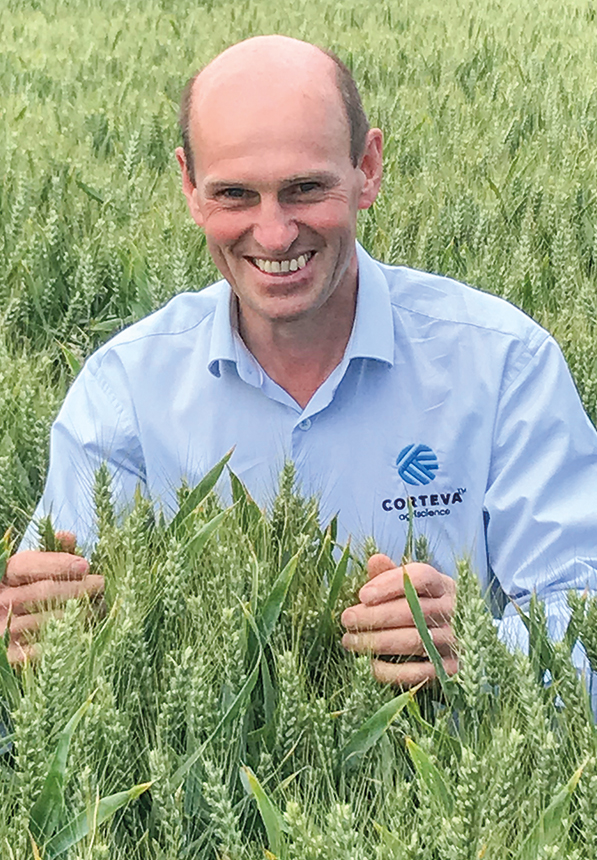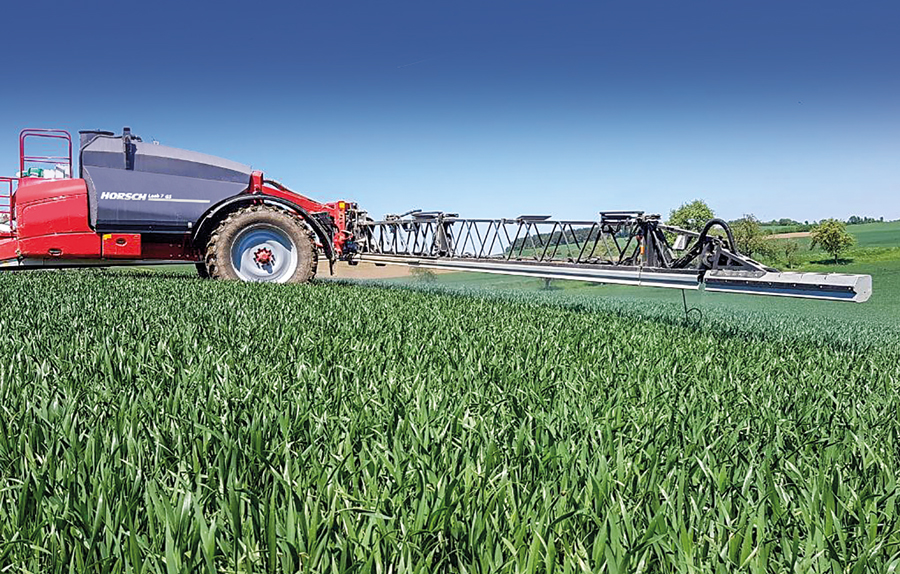Corteva’s pipeline fungicide Inatreq in action
5th July 2019
A new active ingredient targeting septoria and other key diseases in wheat is expected to be approved in time for applications in spring 2020, Corteva Agriscience announced at a special briefing in late June.
A new active ingredient targeting septoria and other key diseases in wheat is expected to be approved in time for applications in spring 2020, Corteva Agriscience announced at a special briefing in late June.
Protectant, curative and with translaminar mobility, Inatreq fungicide activity starts within just half an hour of spraying, said Corteva Agriscience field technical manager Stuart Jackson.
It then spreads in the leaf wax and stays there for many weeks, so when the fungus germinates, the fungicide is then drawn up, killing it.
“It works by inhibiting respiration of the fungus, but at a different point from SDHIs and strobilurins, and it has no cross resistance to current chemistries used for septoria control,” he explained.
Other diseases which are expected to be included on the label include yellow rust, brown rust, fusarium head blight, tan spot, powdery mildew and rhynchosporium.

Corteva Agriscience field technical manager Stuart Jackson
“When spray droplets land on the leaf there is a very rapid redistribution across and down the leaf ridges, giving 97 per cent cover. This means the chance of a spore landing on an unprotected area is very low, leading to consistent control, said Mr Jackson.
“Because of the speed at which just one droplet is able to move to cover the leaf, including the tip, it will be possible to use low water volumes going down to 100-litres/ha and maintain a high forward speed without loss of efficacy, thanks to its unique formulation.”
In trials held by the company for activity on brown rust, the fungicide demonstrated good translaminar movement, moving to the top of the leaf one day after inoculating the underside.
When it comes to application timing, growers are expected to have good flexibility, from GS30 (ear at 1cm) to GS69 (flowering complete).
“It is likely to be the product of choice at T2, but this will depend on varietal resistance and local disease pressure,” continued Mr Jackson. “As the product is taken up by the plant, one of the benefits is the time it remains active in the plant.”
While four weeks after T2, it was hard to see consistent difference between Inatreq and other leading products, company trials plots all showed Inatreq had more than 80 per cent efficacy after 6 weeks, creating a wide difference with competitor activity, he said.
He is hoping that two applications of the fungicide per crop will be approved at registration, but admits this may be unlikely given the range of alternatives available.
Initial registration will be for use on spring and winter wheat, triticale and rye, with the application for barley estimated to be given one or two years later.
Taking the pressure off SDHIs
The active fenpicoxamid belongs to a new class of chemistry called the picolinamides, which has no cross-references to triazoles, strobilurins or SDHIs, he revealed.
“It is a quinone inside inhibitor (Qii) and the only other use for this class of chemistry at the moment is for potato blight control.”
However, insisted Mr Jackson, Inatreq is not effective on blight nor are the blight sprays effective on septoria.
The fungicide is active on a unique target site, but as it is a single site, it will only be available in formulation with prothioconazole to help protect its efficacy.
Nevertheless, it is expected to be an effective tool in the fight against resistance and, so far, no isolates have shown reduced sensitivity. Moreover, isolates resistant to epoxiconazole and pyraclostrobin showed sensitivity to Inatreq.
“We will be recommending Inatreq is used as part of an integrated crop management (ICM) strategy and in mixes which include azoles, strobilurins and SDHIs, so there is multi-site activity delivering broader spectrum disease control.
Natural source
Developed from a secretion produced by a soil-borne streptomyces species called UK2A, the new fungicide is of natural origin. “Once we had discovered the efficacy, our next challenge was to make it photo-stable on the crop,” said Mr Jackson. “We found adding a hydroxy group overcame this problem, and the fungus and the plant then convert it back into UK2A, the active substance.”
With a half-life in the soil of four days, it has a good environmental profile and does not affect soil bacteria, said Mr Jackson.
“Having new modes of action available is essential and using them in conjunction with existing chemistry we can slow the development of resistance in other groups.
“Inatreq is highly active on septoria and has both curative and preventative activity which is a key attribute in the battle to control the most difficult pathogen we have in UK wheat crops.”

